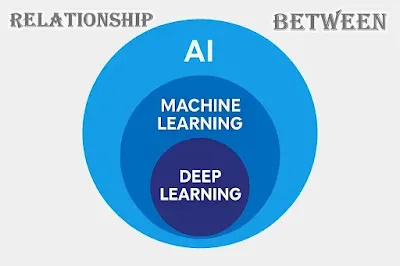If you've spent any time reading about technology, you've undoubtedly run into the terms Artificial Intelligence (AI), Machine Learning (ML), and Deep Learning (DL). They are often used interchangeably, creating a confusing landscape for anyone trying to understand the field. But what's the real difference between them? And how do they relate to one another?
In this guide, we'll clear up the confusion once and for all. We'll break down each concept, show you how they fit together, and provide simple, real-world examples.
The Big Picture: A Simple Relationship and the Key AI Machine Learning Difference
The easiest way to understand the relationship is to think of them as Russian nesting dolls, where each one sits inside the other. AI is the largest, outermost doll; Machine Learning is a doll inside it; and Deep Learning is the smallest, innermost doll.
This hierarchy is the key AI machine learning difference that most people miss. They aren't competing concepts; they are building blocks. Let's look at it visually.
What is AI? (Is Machine Learning a Form of AI?)
Artificial Intelligence (AI) is the broadest and oldest concept of the three. It's the overarching goal of creating machines that can think, reason, and make decisions like a human. Think of AI as the entire field of study, like "Biology" or "Physics."
So, to answer the common question: Yes, Machine Learning is a form of AI. It's one of the most important and successful approaches we've developed to achieve the grand goal of artificial intelligence.
What is Machine Learning? The Core Diff Between AI and ML
Machine Learning (ML) is a specific subset of AI that focuses on a single, powerful idea: systems can learn from data. Instead of being explicitly programmed with rules for every possible scenario, an ML model is "trained" on vast amounts of data, allowing it to identify patterns and make predictions on its own.
This is the core diff between AI and ML. AI is the goal (a smart machine), while ML is one of the primary methods to get there (a machine that learns).
What is Deep Learning? An Advanced Subset of Machine Learning
Deep Learning (DL) is a highly specialized subfield of Machine Learning. Its main feature is the use of complex, multi-layered "neural networks" inspired by the structure of the human brain. This layered structure is what the "deep" in Deep Learning refers to.
Deep Learning truly shines when dealing with massive datasets and unstructured data like images, videos, and natural language. This is why it powers some of the most advanced applications today, from voice assistants to self-driving cars.
Head-to-Head Comparison: A Cheat Sheet for You
To make the differences even clearer, here's a quick comparison. The following table breaks down the key characteristics of Machine Learning and Deep Learning side-by-side.
[IMAGE SUGGESTION 4: A clean, professional-looking comparison table graphic. Columns: "Feature," "Machine Learning," "Deep Learning." Rows: "Data Volume," "Performance," "Hardware Needs," "Example." Use icons and short text.]
Frequently Asked Questions (FAQ)
What is the main difference between Machine Learning and Deep Learning?
The main difference is the architecture. Deep Learning uses a complex, multi-layered neural network, while traditional Machine Learning relies on simpler algorithms. As a result, Deep Learning requires much more data but can handle more complex tasks, especially with images and text.
Is Deep Learning always better than Machine Learning?
Not at all. For many common business problems with structured data (like sales forecasting or customer segmentation), traditional Machine Learning models are faster, cheaper to train, and often just as effective. Deep Learning is the right tool for highly complex tasks with vast amounts of unstructured data.
How do AI, ML, and DL work together in a real product?
Think of your smartphone's camera. The AI goal is to have a "smart camera." To achieve this, it uses Machine Learning models. Specifically, it uses a Deep Learning neural network trained to recognize faces, allowing it to automatically focus on them when you take a picture.
Conclusion: Understanding the AI, ML, DL Difference for Your Career
You now have a clear framework for understanding the AI, ML, and DL difference. They aren't interchangeable buzzwords, but a family of technologies with a clear relationship: AI is the dream, Machine Learning is the method, and Deep Learning is the advanced engine driving some of the most exciting innovations.
Grasping this hierarchy doesn't just make you more knowledgeable—it gives you an edge in understanding the technology that is shaping our future.
Ready to see how machines are learning to see the world?
Dive into our next guide: An Introduction to Computer Vision: How Machines Learn to See.



